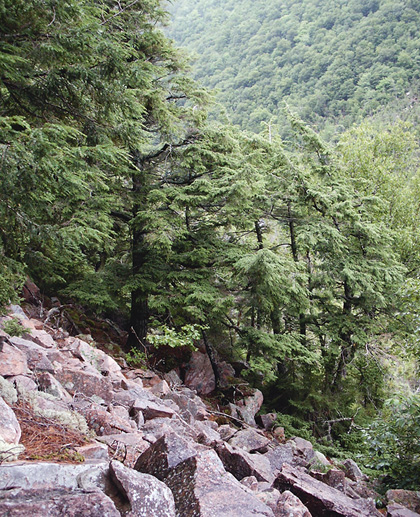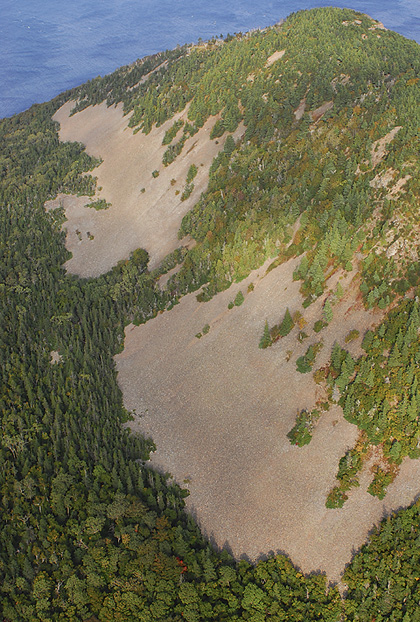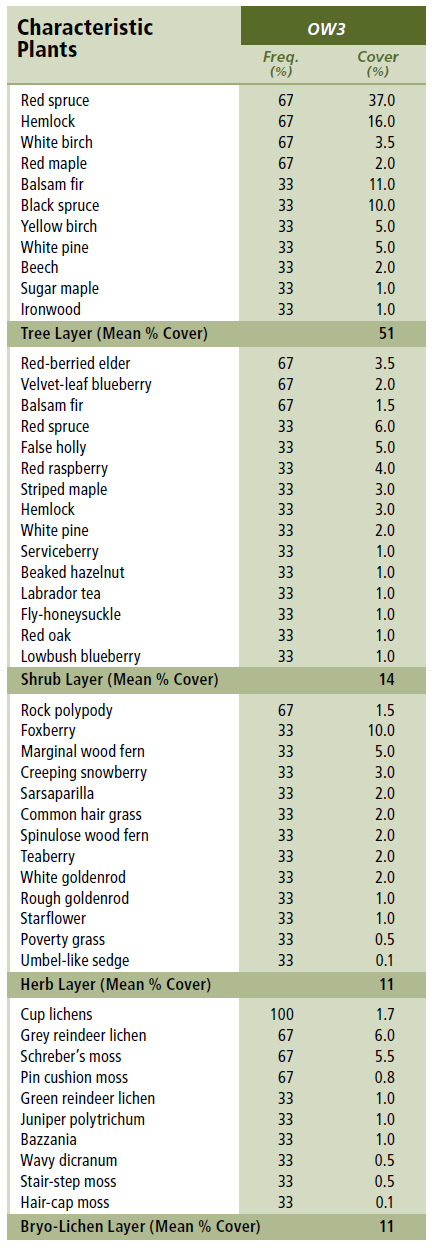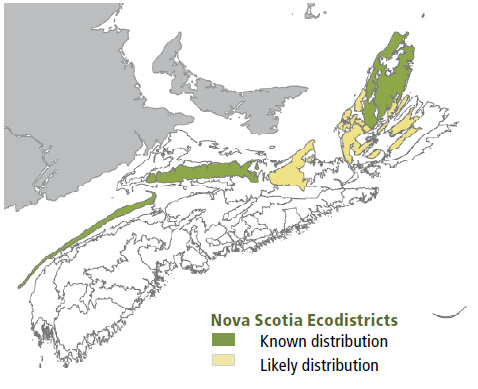
Forest Vegetation types - OW3
OW3 — Red spruce / Red-berried elder / Rock polypody
Picea rubens / Sambucus racemosa / Polypodium virginianum
 |
Cheticamp River Valley, Cape Breton Highlands National Park, Inverness County |
Concept: This somewhat uncommon woodland is characterized by its open coniferous canopy, low species richness and unique talus substrate. It is found only in areas where topography and bedrock outcropping allow the formation of talus slopes. Sites often contain only patches of vegetation across a broader talus matrix. Red spruce, black spruce and/or hemlock are common canopy dominants, and the understory is similarly variable. OW3 is comparable to OW6 (White birch – Red oak – White ash / Marginal wood fern – Herb-Robert), but is generally associated with less fertile substrates.
Vegetation: The poorly-developed canopy may be dominated by a number of evergreen tree species, but sampled stands support high levels of red spruce or hemlock. Understory associates include vascular plants common to acidic conifer forest and/or rocky substrates (e.g. foxberry, rock polypody, marginal wood fern), but most of these species are infrequent. Bryophyte cover is usually low. On older sites, shrubs and bryophytes may form a mat over underlying talus.
Environmental Setting: This ecosystem is found on talus deposits. On steeper grades and/or upper slope positions, talus can be unstable, but older downslope deposits are less mobile and more suitable for plant growth. Trees and other plants are sometimes rooted in underlying mineral soil, but more often in pockets of organic matter and weathered rock found among surface rock fragments. Mineral soil (if present) is usually acidic and dry. Exposure is moderate to extreme. Most occurrences are in the Cape Breton Highlands and Nova Scotia Uplands ecoregions. The Vegetation Type (VT) is scattered across New Brunswick.
Successional Dynamics: This ecosystem is an early to mid-successional stage, but mechanisms for establishment and renewal of this VT are not well understood. As soils deepen over talus, the ecosystem will advance to include features more typical of upland conifer forest, but their expression will be weakened by inherent soil stoniness and related restrictions in rooting potential and nutrient availability.
Ecological Features: Softwood talus woodlands are uncommon small patch ecosystems that are both under sampled and poorly understood in Nova Scotia. Plots were established in warmer areas of the province, where temperate flora are more common. Stronger boreal expressions are expected in cooler areas of Cape Breton. Red spruce / Red-berried elder / Rock polypody woodland supports remarkably unique habitat conditions, but most associated animal, plant and lichen species are undocumented. Exceptions include the rock vole, Gaspé and long tailed shrews, and various land snails. Canopy closure is variable but stand structures tend to be complex, supporting diverse microhabitats. The ecosystem has moderate potential to develop old growth where slopes have stabilized.
 |
| Talus slope, CBHNP (Envirofoto) |
Distinguishing Features: This softwood woodland of spruce and hemlock occurs on talus slopes. Rock polypody is common.
| Slope Position: | Crest3 Middle3 Upper3 |
Surface Stoniness: |
(Very - Excessively)10 |
Bedrock Outcrop: |
nd10 |
Elevation Range: |
150 - 220m |
Slope Gradient: |
Moderate7 nd33 |
Aspect: |
South7 nd3 |
Exposure: |
Mod. exposed7 nd3 |
Microtopography: |
nd10 |
Drainage: |
nd10 |
Soil Type: |
nd10 |
Parent Material: |
Colluvium10 |
Rooting Depth (cm): |
(<30)7 nd3 |
Duff Thickness (cm): |
nd10 |

